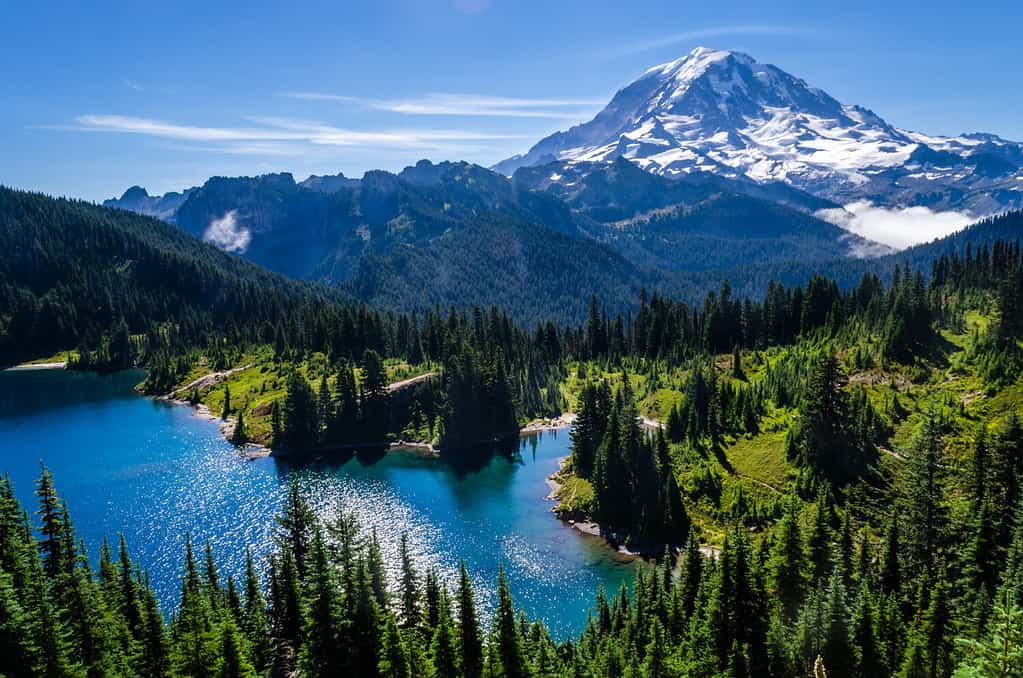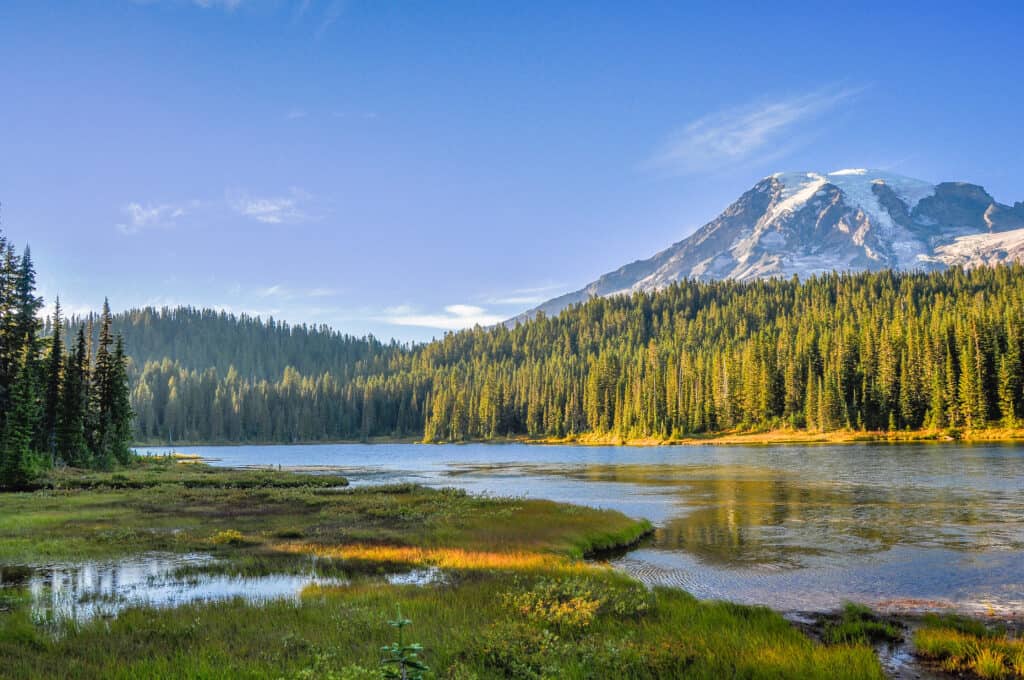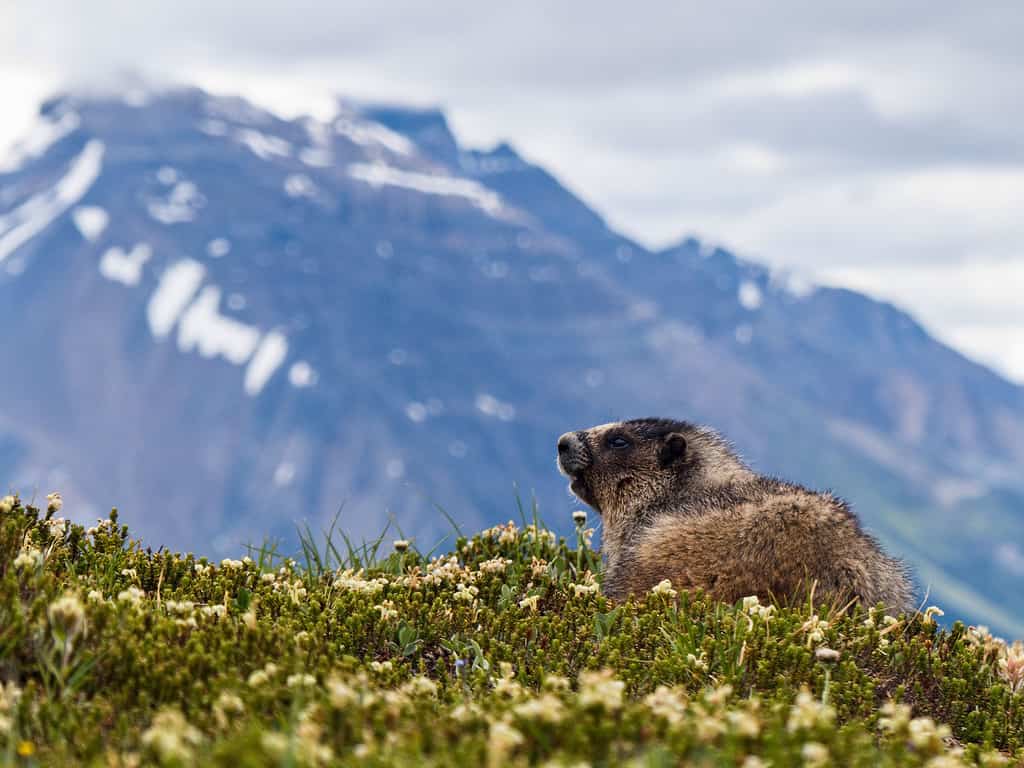Nestled amidst the breathtaking landscapes of the Pacific Northwest, Mount Rainier, or Tahoma, is one of the most beautiful mountains in the United States. With its impressive height, it is the tallest mountain in the state of Washington. Located in the heart of Washington State, this iconic stratovolcano offers a stunning sight for locals and visitors.
Mount Rainier also holds a deep cultural significance as it is a sacred land for Indigenous tribes, such as the Puyallup Tribe, with historical and spiritual connections to the mountain. Yet, if Mount Rainier is a stunning landscape, it is also home to thriving wildlife and holds a cultural and beloved significance for Washington residents. Let’s discover more about Washington’s iconic highest summit, Mount Rainier.
Mount Rainier — and its highest peak, Columbia Crest — is 14,411 feet (4,392 meters) tall.
Where Is Mount Rainier Located on the Map?
Nestled in Central Washington, Mount Rainier is located approximately 59 miles (95 kilometers) southeast of Seattle and 265 miles (426 kilometers) of Spokane.
Often snow-capped, it is an incredible sight to admire, even from afar. Mount Rainier is within the Cascade Range, an extensive volcanic mountain range stretching from Northern California to British Columbia, Canada. As an active volcano, Mount Rainier is part of the Pacific Ring of Fire, the most volcanically and seismically active zone globally.
How Does Mount Rainier Compare to Other Summits in the U.S.?

How is Mount Rainier? The mountain stands 14,411 feet (4,392 meters) tall!
©Thye-Wee Gn/Shutterstock.com
With an elevation of 14,411 feet (4,392 meters) above sea level, Mount Rainier stands as one of the tallest mountains in the United States. Countrywide, it ranks as the 17th highest summit. Mount Rainier is also part of the “14ers” or “Fourterneers” club, as it stands at over 14,000 feet.
The highest summit is determined by how high the mountains stand above sea level. The prominence is of how high the mountain rises over its surroundings.
In terms of prominence, Mount Rainier, with 13,246 ft (4,037 m), ranks third in the United States (behind Denali and the Mauna Kea) and first in the contiguous U.S. It is also the 21st most prominent peak!
Let’s compare Mount Rainier to other U.S. summits!
| Summit Name | Location | Elevation (Feet) | Elevation (Meters) |
|---|---|---|---|
| Mount Denali | Alaska | 20,310 | 6,190 |
| Mount Foraker | Alaska | 17,400 | 5,304 |
| Mount Fairweather | Alaska / British Columbia | 15,325 | 4,671 |
| Mount Whitney | California | 14,505 | 4,421 |
| Mount Elbert | Colorado | 14,440 | 4,401 |
| Mount Rainier | Washington | 14,411 | 4,392 |
| Grand Teton | Wyoming | 13,775 | 4,209.1 |
| Kings Peak | Utah | 13,534 | 4,125 |
| Parry Peak | Colorado | 13,397 | 4,083 |
| Haleakalā | Hawaii | 10,023 | 3,055 |
How Did Mount Rainier Form?

Mount Rainier is a volcano classified in the stratovolcano family.
©KYPhua/Shutterstock.com
Mount Rainier is a product of complex geological processes that span millions of years. Its formation is linked to the Pacific Northwest’s geological history of the Pacific Northwest.
Mount Rainier is a relatively young stratovolcano. However, it is standing on a foundation of rocks millions of years old.
- Puget Group: 40+ million years ago
- Ohanapecosh Formation: 36-28 million years ago
- Stevens Ridge Formation: 26 million years ago
- Tatoosh Granodiorite: 18-14 million years ago
- The Cascade Range started to rise through subduction 10 million years ago
Mount Rainier’s Formation
Approximately two to one million years ago, an ancestral volcano existed at Mount Rainier’s current spot. During a period of low volcanic activity, the volcano eroded, and modern Mount Rainier started to rebuild.
Standing on a subduction zone, the formation of Mount Rainier is due to the interaction between the Juan de Fuca plate, an ocean plate, and the North American Plate. When the subduction plate — in this case, the Juan de Fuca plate — is forced under another one, it triggers chemical changes that lower the rock melting point. The subducting plate then melts, creating magma chambers. Some lava bubbles all the way to the surface and erupts out of Mount Rainier as lava.
Over 500,000 years, successive mountain eruptions led to a slow accumulation of volcanic material — ash, lava, rock, and pyroclastic flow — which built Mount Rainier’s foundation. These repeated eruptions and the layers of volcanic materials gave the mountain its cone shape.
Additionally, Mount Rainier’s lava is relatively low in viscosity, meaning that it flows more easily. This type of lava is known to build tall, steep-sided volcanoes, like most stratovolcanoes.
Mount Rainier is still classified as an active volcano. It hasn’t had a significant eruption in the last 500 years, even though its last eruption is believed to be the last recorded eruption between 1820 and 1854. However, Mount Rainier is closely monitored as it is considered the most dangerous in the Cascade Range. The volcano is one of the most exposed to earthquakes. In the worst case, it could trigger an eruption or destabilize one of the mountain’s 25 glaciers and become a dangerous and giant mudslide.
Today, the mountain continues to be shaped by ongoing geological forces, including glacial activity, with its two glaciers, the Emmons and Nisqually Glaciers.
What Are the Wildfire Risks at Mount Rainier?

The region’s climate, topography, and vegetation can easily foster wildfires, especially during the summer.
©Vidpen/Shutterstock.com
Wildfires are a significant concern, specifically at Mount Rainier National Park. While the mountain is built mainly of volcanic material, its lower slopes and surroundings are home to thriving ecosystems, often threatened by wildfires.
With its diverse ecosystems, ranging from lush forests to subalpine meadows, Mount Rainier is at risk of wildfires, specifically during dry periods in late summer. At this period, rainfall is significantly low, and dead vegetation accumulation can dangerously fuel wildfires. A large amount of natural fuel — branches, leaves, or spines — can transform a small fire into a mega-fire, quickly overpowering firefighting forces. Additionally, lightning sometimes brings some destroying wildfires. In the summer, thunderstorms often break in the region after days of scorching temperatures. With them, lightning can occur and ignite one or multiple fires.
Finally, human-related fires are also a common cause of fires. In the summer, with an environment extremely dry, a campfire left unattended, a discarded cigarette, or even the sunlight reflection on a broken mirror or sunglasses (on the ground) can be enough to start a fire.
Notable Fires
Even with fire prevention, Mount Rainier has already suffered from destructive wildfires.
In 1991, the Boundary Fire started in the Stephen Mather Wilderness of Mount Rainier National Park. This wildfire destroyed over 4,000 acres and threatened park infrastructure. It took a lot of firefighting efforts to contain it.
More recently, in 2015, the Mildred Fire was ignited when lightning struck Mount Rainier National Park’s backcountry. Thanks to the firefighters’ fast and effective response, only 500 acres burned. However, the fire still led to the temporary closure of hiking trails in the area.
To manage wildfire risks around Mount Rainier, the National Park Service, U.S. Forest Service, and local firefighting agencies work hand in hand. Park officials and park rangers monitor weather conditions and implement fire restrictions. Sometimes, they voluntarily start controlled burns to reduce the buildup of flammable vegetation.
Mount Rainier National Park is visited by millions every. Visitors are highly encouraged to practice fire safety and adhere to park and fire regulations. In addition, visitors need to stay vigilant to prevent human-caused wildfires. With its rules and fire safety practices, the park aims to protect and preserve its diverse ecosystems and the natural beauty of this iconic region.
What Wildlife Live on Mount Rainier?

Hoary marmots live throughout North America. They are widespread in Alaska and in Yukon, Canada.
©Wirestock/iStock via Getty Images
With an extensive array of ecosystems, from rainforests to alpine meadows, Mount Rainier is home to multiple ecosystems, providing habitat for a large variety of wildlife. Mount Rainier’s National Park encourages visitors to participate in safe wildlife-watching practices. Park staff also promote initiatives and efforts to protect and preserve its wildlife and ecosystems.
Mammals
First, Mount Rainier is home to many large and small mammals. The iconic black bear inhabits the more mountainous zones of the park. However, this species is often seen by visitors when foraging for food. More elusive and hard to spot, mountain lions or bobcats live in the park’s forested areas. Mule deer and elk cohabit in the national park and are a common sight for visitors.
When looking up at the steeped slopes of Mount Rainier, visitors can spot mountain goats. This species is famous for its agility and capacity to maneuver on incredibly steep surfaces. Their sightings are common in the park, and visitors can enjoy the spectacle of their surprising agility.
Bobcats, red foxes, and marmots also inhabit the park and tend to live in the forested areas. Additionally, smaller mammals like the chipmunks, the Douglas squirrel, and voles inhabit the subalpine and alpine meadows. They are familiar sights in these areas, where they often forage and play in the open spaces.
Lastly, hoary marmots live in the subalpine and alpine areas of the park. These social rodents enjoy sunbathing in wide open spaces, often in rocky areas. They can be seen scanning their surroundings and whistling to alert their group of potential threats.
Birds
If you visit the park, don’t forget to look up into the sky because Mount Rainier’s thriving avian wildlife won’t disappoint you. First, it is home to the majestic bald eagle, golden eagles, and peregrine falcons. While these birds are not the easiest to spot, they can sometimes be seen on branch trees or soaring over the water, looking for food. On a lucky day, visitors can spot them while diving into the water to scoop their prey.
Birds of smaller size, like the northern spotted owl and various songbirds — such as juncos and warblers — inhabit the park’s forests. White-tailed ptarmigans prefer the living environment of high alpine areas.
Fish
Rivers and streams are vital ecosystems for Mount Rainier National Park. They support the natural ecosystem but also its wildlife, specifically fish consumers. The cutthroat and rainbow are teeming in the park’s waters. They are a favorite for anglers as these species are always challenging to catch. Plus, it is also home to the critically endangered bull trout. The park is making efforts to protect and restore the aquatic ecosystems.
Amphibians and Reptiles
Some amphibians and reptiles live in the park in smaller numbers than the larger wildlife. The northwestern salamander, the Pacific tree frog, and the western territorial garter snake are widespread throughout the park.
Butterfly
The park is also home to various insects, including bees, butterflies, and dragonflies. Specifically, the park is home to the beautiful and endangered Oregon silverspot butterfly.
The photo featured at the top of this post is © Jeff Westhead/Shutterstock.com
Thank you for reading! Have some feedback for us? Contact the AZ Animals editorial team.







